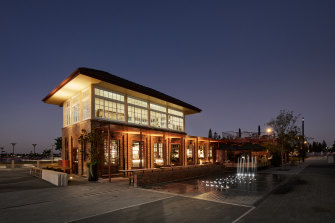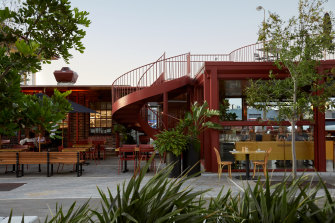Heritage-listed signal box transformed into eatery
Sometimes the most significant buildings can be the most modest.
This is certainly the case with the state heritage-listed signal box, adjacent to the Hunter River foreshore in Newcastle.
Originally part of the Newcastle Railway Station Group of 1858 when a number of railways were introduced to New South Wales, the Newcastle signal box was then rebuilt in 1936, with many of the parts imported from Britain.

The Hunter Central Coast Development Corporation, which oversaw this development, was keen to not only restore and find a new use for this relic, but also create an offering that would respond to the recently completed parkland designed by landscape architects JMD Design.
Reworked and extended by Derive Architecture & Design, who worked closely with heritage architects the Carste Studio, this modest project received the Francis Greenway Heritage Award from the Australian Institute of Architects (NSW).

“It’s those small moments you start to appreciate in these buildings,” says architect Jason Elsley, director of Derive Architecture & Design.
In the process, much of the station’s original structures and equipment was discovered, such as the type ‘O’ masonry turntable signal box, and the original precast wrought iron staircase.
With the decision to create a new informal restaurant for local identity Andrew MacDonald and to repurpose the signal box to create the restaurant’s kitchen, there’s a fine meshing of materials and structures through the two buildings.
The new steel pavilion, with its five massive tilt-up glazed doors (each weighing 500 kilograms) allows diners to feel part of the outdoor experience and, importantly, provides cross ventilation.
While there are no longer railway tracks (they have been embedded in concrete as a reminder) diners can still feel they have arrived on the platform.
The blood-red oxide pavilion and awning, with its expressed streel beams, gives a subtle nod to the past.
“We wanted to acknowledge the Sydney red rattlers that once used the line, as much as the red oxide you see with ships in the port,” says Elsley.
Part of the renovation included a curvaceous new external steel staircase that leads to the rooftop above the new pavilion, allowing the general public to enjoy a similar vista to that of the station master as far back as 1836 when trains ended their journey here.
Although Elsley and his team hadn’t previously reworked a signal box, he became completely engrossed with every step of the process, appreciating the archaeological digs as much as designing the new work.
“Many of these structures came from the United Kingdom, including the last remaining set of miniature pneumatic lever gears to arrive on our shores,” says Elsley.
With the new pavilion and outdoor seating areas allocated to diners (approximately 250 patrons in total), the original signal box was transformed into a galley-style commercial kitchen, along with a bar.
Lightly touched, and incorporating the original steel beams and columns, the signal box at the mezzanine level includes the operating equipment before the heavy rail was decommissioned.
“You don’t have to dine at the restaurant to enjoying seeing the history,” says Elsley.
While the new steel dining pavilion is clearly a new structure, other moves by Derive Architecture are far from obvious.
A couple of the original windows in the signal box, for example, had to be extended to form doorways.
A few of the other pivotal steel windows were transformed into a canteen-style to allow food to be delivered to those dining outdoors.
However, the signal box, with its distinctive Flemish bond patterned bricks, forms part of the new experience for diners, or for those simply wanting to learn more about railway history.
“It’s been a fascinating journey for everyone who has worked on this project, engaging with the historical narrative and seeing the adaptive re-use of a building so ingrained in the Newcastle psyche,” adds Elsley.
Most Viewed in Business
Source: Thanks smh.com